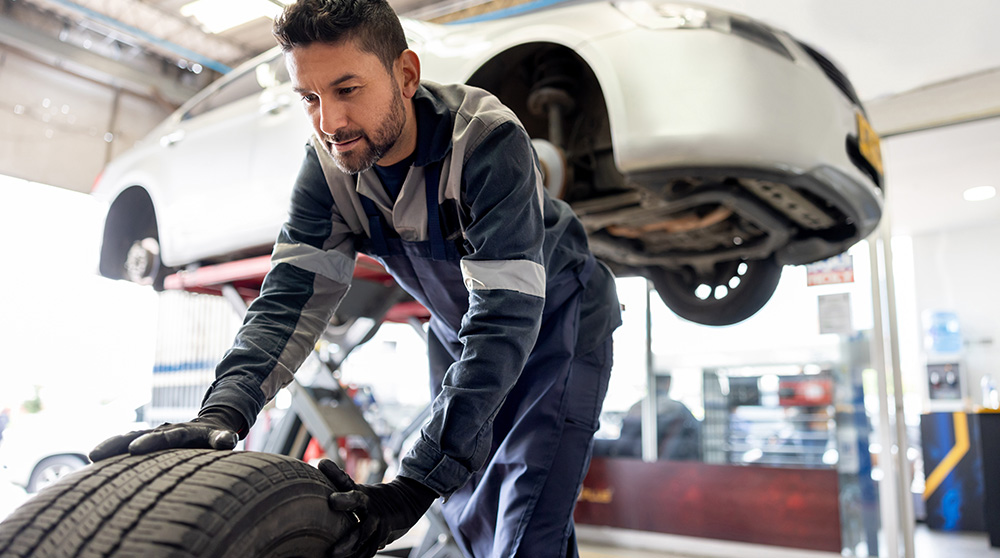Whether you’re installing a new part, completing a paint job, or rebuilding a vehicle, no two auto service repair shop jobs are the same. Each one brings different risks and challenges, which is why protecting your employees, and your business, should be your top priority.
Not sure where to start? We’re sharing our expert tips for auto service repair shops:
- Wear shoes with non-slip soles. Increase protection from slips and falls with the right footwear. Sturdy shoes provide a strong foundation and protect your feet from injury if something falls on them.
- Gear up with gloves. Almost everyone is exposed to things that could hurt their hands, like chemicals, hot engines, and sharp tools. Equip your team with ample personal protective equipment (PPE) and enforce rules for wearing it throughout the day.
- Protect your eyes. Offer safety goggles that cover the eyes completely. Train team members on tips for wearing PPE correctly to further prevent injury.
- Clean spills and slick spots. Much automotive maintenance involves changing oil and transmission fluid, both of which can coat the garage floor and increase the risk of slips. Instruct employees to quickly clean up or mark spills with signage to help reduce falls.
- Label your chemicals. You don’t want your team to question which fluid is in which container. Label them boldly and clearly.
- Store chemicals separately. Any chemicals that could catch fire should be stored far from ignition sources. Establish safe zones for chemical storage.
- Get rid of shop rags. Once a rag has wiped off oil or any other flammable substance, it becomes a fire hazard. Because of the heat inside so many auto service and repair shops, rags can combust if they’re not disposed of properly. Be sure to store all used rags in a UL-listed metal waste container equipped with a spring-loaded lid. The contents of the containers should be disposed of daily or at the end of each shift.
- Use insulated tools for electrical work. Car batteries, wiring, and electronic components can carry high voltages. Using insulated tools, such as pliers, screwdrivers, and wrenches with non-conductive handles, prevents the risk of electrical currents traveling through the tool and into the body.
- Get safety data sheets from manufacturers. Make sure you use and store your equipment according to their specifications.
- Allow proper ventilation. Working with chemicals can cause respiratory irritation and infection. Ensure your shop has enough ventilation to maintain good air quality.
- Install smoke and carbon monoxide detectors. Regularly test these devices to ensure they function properly.
- Keep fire extinguishers in your shop. Employees shouldn’t have to walk more than 50 feet to find one. Train team members so they know where fire extinguishers are located and how to use them.
- Enforce a “no smoking” policy. The smallest spark can send things up in flames, so implement a strict policy against smoking in the shop. Designate an area a safe distance away from the shop where team members can go.
- Update your paint booth. All paint booths should have explosion-proof wiring, explosion-proof lighting, and proper ventilation.
- Don’t eat or drink in the shop. Any chemicals in the air could contaminate your food. If possible, establish a separate break room or lunchroom with a sink for washing up before eating.
- Stock a first-aid kit. For cuts, scrapes, and bruises, keep a first-aid kit easily accessible.
Following these auto service repair shop safety tips can help keep your property, team, and customers safe. Looking for more ways to protect your business? Our local, independent agents will help you get the coverage you need. Talk to one today.
This content was developed for general informational purposes only. While we strive to keep the information relevant and up to date, we make no guarantees or warranties regarding the completeness, accuracy, or reliability of the information, products, services, or graphics contained within the blog. The blog content is not intended to serve as professional or expert advice for your insurance needs. Contact your local, independent insurance agent for coverage advice and policy services.


